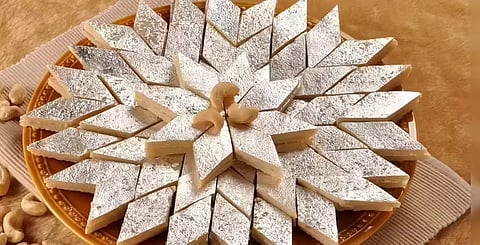
- Home
- Live Blog
- Breaking News
- Top Headlines
- Cities
- NE News
- Sentinel Media
- Sports
- Education
- Jobs

Step into an Indian sweet shop during the festive season, and you’ll be greeted by trays of kaju katli, barfi, and laddoos gleaming under silver light. That fragile shimmer, known as vark or chandi ka varq, is more than just decoration. For centuries, it has symbolized purity and prosperity. But behind its beauty lies a fascinating story of artistry, empire, Ayurveda, and ethical debate.
The practice of coating food with precious metals dates back over 2,000 years. Ancient Ayurvedic texts mention rajata bhasma (silver ash) and swarna bhasma (gold ash) as medicinal ingredients believed to purify blood, cool the body, and enhance vitality. Silver’s natural antimicrobial properties even made it an early preservative, keeping food fresh before the era of refrigeration.
Over time, this medicinal tradition evolved into an art form. In royal courts, from the Mughals in Delhi to the Nawabs of Awadh, silver and gold were used to gild sweets, meats, and rice. Dishes like Moti Pulao (rice grains coated in silver and gold) and Chandi Qaliya became edible works of art, serving as symbols of power and refinement.
For generations, the creation of vark remained a craft passed down within families of silversmiths. Traditionally, artisans placed thin strips of pure silver between sheets of parchment and pounded them for hours until the metal stretched into nearly weightless sheets, less than one thousandth of a millimeter thick.
Historically, that parchment wasn’t paper; it was made from animal intestines or hide. The elasticity of the membrane helped achieve the delicate texture needed to produce perfectly thin silver foils. This detail remained largely unknown until the late 20th century, when investigations revealed that animal tissue was commonly used in the process.
That revelation stirred controversy across India. For many Jains and vegetarians, the idea of animal by-products touching food was unacceptable. Religious groups called for stricter regulations, and in 2016, India officially banned the use of animal intestines in the production of edible silver and gold leaf.
Today, most vark is made using plant-based or synthetic materials such as food-grade polyester or treated paper. These “vegetarian” versions have largely replaced the old methods, though some traditional craftsmen still argue that animal parchment produced finer results. So, is vark vegetarian now? Mostly yes, but not always. While reputable sweet makers use certified vegetarian silver, cheaper, unregulated foils can still be questionable in origin or purity. (Agencies)
Also Read: Hidden clues in your armpits that reveal your breast health